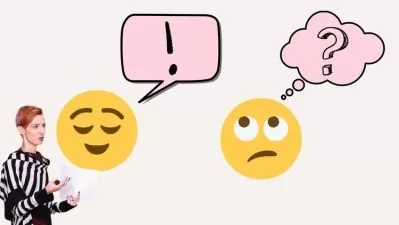Nonverbal Communication Techniques for Business Success
Vasco Patrício
1:41:38
Description
Mastering body language, gestures, vocal tonality, and other elements of subcommunication to succeed in business/life!
What You'll Learn?
- You'll learn how to improve your body language when speaking or communicating
- You'll learn techniques to speak with more clarity, be more respected, and just communicate more efficiently
- You'll learn about the different elements of body language, vocals, the way you dress, and other important subcommunication building blocks
- You'll learn what actions and behaviors make you more respected and heard as a communicator
Who is this for?
What You Need to Know?
More details
DescriptionWHATÂ ISÂ LEFTÂ UNSAIDÂ CANÂ HURTÂ YOU
When speaking, presenting, or otherwise communicating in a business context, it's what is left unspoken that, in many cases, counts the most.
These are the nonverbal cues. Your expressions. Your gestures. Your posture. All of these tell their own story, and in any cases a stronger one than your words say.
Regardless of how good you are at speaking, your nonverbals can make you or break. People WILLÂ read your signals, whether you want them to or not.
But... there aren't many courses that go deep into nonverbals, and how to optimise them.
As a seasoned executive coach, I've worked with high-profile clients throughout the years, and the lessons in this course are the product of these hundreds of hours of training and fine-tuning.
This course on nonverbal communication is one of the most (if not the most) comprehensive courses you will find on body language, vocals, gestures, tension, and other elements of subcommunication that are so important to your message.
LETÂ MEÂ TELLÂ YOU... EVERYTHING
Some people - including me - love to know what they're getting in a package.
And by this, IÂ mean, EVERYTHING that is in the package.
So, here is a list of everything that this course covers:
What the usual communication fears are, and how to apply techniques to both identify and tackle them, as well as how accepting them improves your communication;
How to calibrate your body language for different situations, including gestures and poses;
How to calibrate different elements of your vocals, including pitch, pace, volume and more, to create different effects when communicating;
The role of your clothing, grooming, and style, as well as details to be aware of when communicating;
The role of harmony when presenting, as well as how to be more mindful to relax your body physically;
How to draw boundaries effectively, without ruining your communication or hurting the relationship;
How to resolve conflicts between others, using diplomacy, and communicating effectively while doing it;
How to make conversation and small talk with others, in multiple settings;
What emotional intelligence is, and how to make use of it in situations of strong emotions;
How to hold the tension and use silence, eye contact and vocal tone to make the other side concede before you do;
What types of humor can be used in communication, which are acceptable, and how to use them;
How to show respect for others equally, regardless of their status, and how to avoid coming across as sleazy;
MYÂ INVITATIONÂ TOÂ YOU
Remember that you always have a 30-day money-back guarantee, so there is no risk for you.
Also, I suggest you make use of the free preview videos to make sure the course really is a fit. I don't want you to waste your money.
If you think this course is a fit and can take your knowledge of subcommunication and nonverbals to the next level... it would be a pleasure to have you as a student.
See on the other side!
Who this course is for:
- You're someone who is already a good communicator and presenter, but wants to improve their nonverbal communication
- You're someone who wants to be more respected and seem more credible in presentations
- You're someone who is curious about communication and speaking
WHATÂ ISÂ LEFTÂ UNSAIDÂ CANÂ HURTÂ YOU
When speaking, presenting, or otherwise communicating in a business context, it's what is left unspoken that, in many cases, counts the most.
These are the nonverbal cues. Your expressions. Your gestures. Your posture. All of these tell their own story, and in any cases a stronger one than your words say.
Regardless of how good you are at speaking, your nonverbals can make you or break. People WILLÂ read your signals, whether you want them to or not.
But... there aren't many courses that go deep into nonverbals, and how to optimise them.
As a seasoned executive coach, I've worked with high-profile clients throughout the years, and the lessons in this course are the product of these hundreds of hours of training and fine-tuning.
This course on nonverbal communication is one of the most (if not the most) comprehensive courses you will find on body language, vocals, gestures, tension, and other elements of subcommunication that are so important to your message.
LETÂ MEÂ TELLÂ YOU... EVERYTHING
Some people - including me - love to know what they're getting in a package.
And by this, IÂ mean, EVERYTHING that is in the package.
So, here is a list of everything that this course covers:
What the usual communication fears are, and how to apply techniques to both identify and tackle them, as well as how accepting them improves your communication;
How to calibrate your body language for different situations, including gestures and poses;
How to calibrate different elements of your vocals, including pitch, pace, volume and more, to create different effects when communicating;
The role of your clothing, grooming, and style, as well as details to be aware of when communicating;
The role of harmony when presenting, as well as how to be more mindful to relax your body physically;
How to draw boundaries effectively, without ruining your communication or hurting the relationship;
How to resolve conflicts between others, using diplomacy, and communicating effectively while doing it;
How to make conversation and small talk with others, in multiple settings;
What emotional intelligence is, and how to make use of it in situations of strong emotions;
How to hold the tension and use silence, eye contact and vocal tone to make the other side concede before you do;
What types of humor can be used in communication, which are acceptable, and how to use them;
How to show respect for others equally, regardless of their status, and how to avoid coming across as sleazy;
MYÂ INVITATIONÂ TOÂ YOU
Remember that you always have a 30-day money-back guarantee, so there is no risk for you.
Also, I suggest you make use of the free preview videos to make sure the course really is a fit. I don't want you to waste your money.
If you think this course is a fit and can take your knowledge of subcommunication and nonverbals to the next level... it would be a pleasure to have you as a student.
See on the other side!
Who this course is for:
- You're someone who is already a good communicator and presenter, but wants to improve their nonverbal communication
- You're someone who wants to be more respected and seem more credible in presentations
- You're someone who is curious about communication and speaking
User Reviews
Rating
Vasco Patrício
Instructor's Courses
Udemy
View courses Udemy- language english
- Training sessions 15
- duration 1:41:38
- Release Date 2023/07/22





















